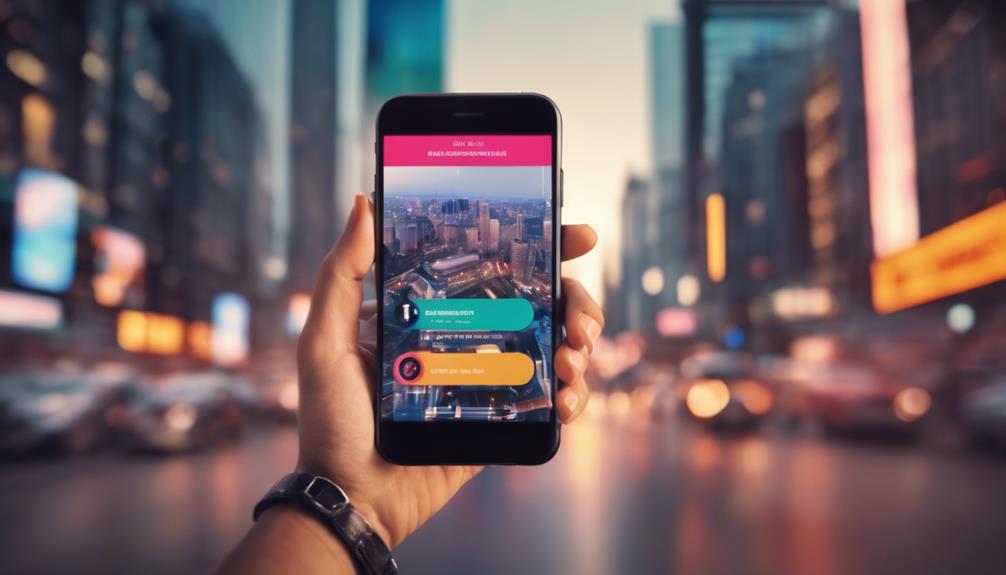Do you know that more than 70% of online searches are now done on mobile devices? This shift has changed how people discover local businesses. If you're not optimizing for mobile, you're missing out on a significant amount of potential local traffic.
Searches for 'Near me' have increased by more than 500%, making mobile SEO not just important, but crucial for local rankings. So, how can you ensure your business stands out in this mobile-first world? Let's dive into why mobile optimization is a game-changer for your local search visibility.
Key Takeaways
Mobile SEO is super important for local rankings because it helps your site show up when people search for things nearby. When your site is mobile-friendly, it's easier for users to find and navigate, boosting your chances of ranking higher in local searches. With 70% of online searches happening on mobile devices, optimizing for mobile is a must. Plus, focusing on mobile SEO can really pay off when people are searching for things "near me," driving more local traffic to your site. By using responsive design, you can ensure a consistent user experience that not only keeps people engaged but also improves your local search rankings.
Growth of Mobile Usage
With mobile devices accounting for over 70% of online searches, it's evident that mobile usage has taken the lead in online search behavior. This shift to mobile-first browsing was solidified in 2016 when mobile searches surpassed desktop searches worldwide. Consequently, optimizing your website for mobile is now more crucial than ever. When users search on their phones, they expect fast and relevant results, especially when seeking local information. In fact, 46% of mobile searches are for local information, highlighting the importance of appearing in local search results.
The impact of a high ranking in local search results on mobile can't be emphasized enough. The top 3 listings in the local pack receive more than 75% of clicks. Therefore, your website's mobile optimization directly affects its visibility and accessibility to potential customers. Neglecting mobile-friendliness could result in a significant loss of traffic and potential business opportunities.
A critical aspect of mobile optimization is ensuring that your site loads swiftly. Research indicates that 61% of users will exit a site if it provides a poor mobile user experience, such as slow page loading times. Therefore, mobile optimization involves not only responsive design but also technical SEO components like page speed.
Websites optimized for mobile perform better in search engine rankings and offer an improved user experience, leading to increased engagement and conversion rates.
Local Search Behavior
There's been a noticeable shift in search behavior, with more than 70% of searches happening on smartphones.
Nearly half of these searches, around 46%, are specifically looking for local information.
This trend is further emphasized by a staggering 500% increase in 'near me' searches, showing a clear preference for location-based queries.
To enhance your local rankings effectively, it's crucial to understand these mobile search patterns and user intent.
Mobile Search Trends
Mobile Search Trends: Why Your Business Can't Afford to Miss Out
Did you know that more than 70% of smartphone searches are aimed at finding local information? It's clear that mobile search trends are on the rise, and your business needs to keep up.
Local search has come a long way, with searches like 'near me' shooting up by over 500% in recent years. This surge shows how people are turning to their mobile devices more than ever to discover nearby businesses and services.
Getting your business to the top of local rankings is crucial. Did you know that over 75% of clicks go to the top 3 listings in the local pack? If your business isn't optimized for mobile, you're missing out on a large chunk of potential traffic.
Mobile search trends reveal that convenience is key for users, making mobile devices the go-to choice for local searches.
But here's the catch: a lousy mobile user experience can do more harm than good. For example, if your website takes ages to load, 61% of users are likely to bounce off, hurting your local rankings.
Prioritizing mobile SEO ensures that your site loads quickly and offers a seamless experience, meeting user expectations and boosting your chances of snagging a top spot in local search results.
User Intent Patterns
Understanding how mobile search trends impact local rankings brings us to user intent patterns. More than half of all Google searches have a local focus, emphasizing the importance of considering local searches on mobile devices.
User behavior shows a strong preference for mobile searches when seeking nearby services or products. 'Near me' searches have seen a substantial 500% increase. These patterns indicate that people heavily rely on their smartphones to quickly find local information while on the move.
Optimizing for mobile is crucial in this context. If your website isn't mobile-friendly, you could be missing out on a significant amount of local traffic and potential customers.
Mobile optimization involves ensuring your site loads quickly, is easy to navigate, and offers relevant local information. These elements not only enhance user experience but also boost your local search rankings. Google's algorithms prioritize mobile-optimized websites for local searches, emphasizing the need to align your SEO strategies with these user intent patterns.
In essence, mobile optimization goes beyond appearances; it's a key factor in attracting local search traffic and boosting your local search rankings.
Proximity-Based Queries
Proximity-based searches are a big deal in mobile search behavior, with more than 46% of mobile searches focused on finding local information. This highlights how crucial these searches are in shaping how people look for things nearby.
For businesses, making it into the top 3 listings in local search results is key since they get over 75% of the clicks. The increase in 'near me' searches, which have spiked by over 500%, shows that mobile users are really keen on finding businesses close by.
When you dive into mobile SEO, you're basically working to boost your business's chances of ranking higher in these local searches. Understanding and catering to proximity-based queries can make a big difference in how well you show up in local search results.
Mobile users are usually on the move, searching for quick and relevant information. That's why your mobile SEO game plan should focus on local keywords and making sure your business details are accurate and current.
User Experience

If you want to boost your local rankings, focus on improving your website's loading speed and ensuring it's mobile-friendly. Studies have shown that sites loading in under three seconds tend to keep users engaged and lower bounce rates.
Moreover, Google gives priority to mobile-responsive sites, so optimizing for mobile is crucial for achieving success in search rankings.
Page Load Speed
Improving your mobile site's load speed is crucial. Did you know that more than half of users will bounce if a site takes over 3 seconds to load? This not only impacts your local search rankings but also affects user experience. Google even factors in page load speed when ranking sites, so it's essential to ensure your site loads quickly to stay competitive.
To boost your mobile site's load times and enhance user experience, focus on the following tips:
- Cut down on HTTP requests: Streamline your page elements to speed up loading.
- Enable compression: Utilize tools like Gzip to compress your files for faster downloads.
- Optimize images: Ensure images are the right size and quality to prevent slowing down load times.
- Utilize browser caching: Store static files locally on users' devices for quicker return visits.
- Improve server response time: Enhance server performance by upgrading hosting and optimizing server settings.
Mobile-Friendly Design
Once you've boosted your site's loading speed, the next step is to ensure your mobile design offers users a top-notch experience. With over half of all website traffic coming from mobile devices worldwide, having a mobile-friendly site is non-negotiable.
Opting for a responsive design guarantees that your website adjusts flawlessly to various screen sizes, crucial for engaging users on different devices.
Google's algorithm gives priority to mobile-friendly sites in search results, significantly impacting your local rankings. Neglecting mobile optimization for local search means potentially losing out on local customers.
A well-crafted, mobile-friendly site can vastly improve user satisfaction, reducing bounce rates and keeping visitors happy.
A responsive design goes beyond just looks; it directly affects your site's functionality and ease of use. Simple navigation, easily readable text without zooming, and well-presented images are key aspects of a mobile-friendly site that can prolong user engagement.
This enhanced user experience can lead to better local SEO performance, driving more traffic and conversions. In today's competitive landscape, having a mobile-friendly site isn't a choice – it's a necessity.
Search Engine Ranking
In today's digital world, Google gives priority to websites that are mobile-friendly when it comes to local search rankings. This emphasis on mobile SEO is crucial for boosting your online presence and attracting more customers to your business.
With mobile devices accounting for over 50% of global web traffic, optimizing your site for mobile is key to improving your local search rankings.
Google's search algorithm favors websites that offer a smooth experience on mobile devices. A mobile-friendly site not only enhances user satisfaction but also helps reduce bounce rates, which play a significant role in determining your local search position.
When visitors have a positive experience and spend more time on your site, search engines recognize this as valuable content, ultimately elevating your local search rankings.
Here are some important points highlighting the significance of mobile SEO for improving your search engine ranking:
- Over 50% of global traffic comes from mobile devices: This underscores the importance of catering to mobile users to reach a large audience.
- Increased visibility and organic traffic: Mobile optimization directly impacts how easily users can find and navigate your site, driving more local traffic.
- Reduced bounce rates: Mobile-friendly sites tend to keep visitors engaged for longer, leading to lower bounce rates and a boost in search engine rankings.
- Alignment with search algorithm priorities: Google's algorithm favors mobile-friendly websites, making mobile optimization essential for local SEO success.
- Enhanced user experience: Providing a seamless mobile experience is crucial for retaining visitors and improving your local search rankings.
Competitive Advantage

Embracing mobile SEO can truly give your business a competitive edge by significantly boosting your visibility and attracting more local traffic. Optimizing your website for mobile devices ensures that you rank higher in local search results, which is crucial for local SEO success. With Google favoring mobile-friendly sites, your business will stand out in 'near me' searches, connecting with more potential customers in your area.
Mobile-friendly websites not only achieve higher rankings but also enhance your brand's reputation and credibility. Providing users with a seamless browsing experience increases the likelihood of them staying on your site, reducing bounce rates and driving conversions. In a competitive landscape, these advantages can differentiate you from competitors who haven't prioritized mobile optimization.
Let's delve into some key metrics where mobile SEO can give you a competitive edge:
| Metric | Mobile-Optimized Site | Non-Optimized Site |
|---|---|---|
| Local Search Ranking | Higher | Lower |
| Bounce Rate | Lower | Higher |
| Conversion Rate | Higher | Lower |
Responsive Design
Responsive design is absolutely crucial for ensuring your website delivers a seamless user experience across all devices, directly impacting your local search rankings. With over half of all global website traffic coming from mobile devices, it's vital that your site adjusts to different screen sizes.
Mobile-friendly websites not only attract users but also rank higher in local search results thanks to their improved usability and accessibility. Google's algorithms prioritize websites that offer a top-notch mobile user experience, and responsive design is key to achieving this. When your website smoothly adapts to various devices, it boosts user engagement and lowers bounce rates. This sends a strong signal to search engines that your site is trustworthy and valuable, ultimately giving your local SEO a significant boost.
Here are some compelling reasons why responsive design should be at the core of your mobile SEO strategy:
- Consistent User Experience: Whether someone visits your site on a smartphone, tablet, or desktop, responsive design ensures they've a consistent experience, building trust and satisfaction.
- Higher Search Rankings: Google gives preference to mobile-friendly websites, so implementing responsive design can greatly improve your local search visibility.
- Improved Engagement: A website that's easy to navigate on any device keeps users engaged for longer periods, lowering bounce rates and increasing conversions.
- Better Performance: Responsive design optimizes your site for different devices, enhancing load times and overall performance.
- Cost-Effectiveness: Managing a single responsive website is more efficient and cost-effective than dealing with separate desktop and mobile versions.
Page Speed Optimization

Improving your website's page speed is crucial for maintaining strong local search rankings and keeping users engaged. Slow loading times can have a significant impact on user experience and your local SEO efforts.
Did you know that more than half of mobile site visits are abandoned if a page takes longer than 3 seconds to load? This high bounce rate can harm your local search rankings since Google considers page speed a key ranking factor.
One effective way to boost mobile performance is by optimizing images. Large, uncompressed images can really slow down your site. By compressing images without losing quality, you can speed up load times and enhance user experience.
Additionally, it's vital to reduce server response times. Quicker server responses mean your content reaches users faster, especially as 70% of global cellular network connections will be 4G by 2025.
The impact of page speed on conversions is undeniable. Just a one-second delay in mobile page load time can lead to a 7% drop in conversions. This statistic emphasizes the importance of prioritizing speed not just for SEO but also for your business success.
Mobile-Friendly Features
To boost your local search rankings and provide a seamless user experience, incorporating mobile-friendly features is key. Mobile users crave smooth interactions, so neglecting this aspect can lead to higher bounce rates and lower search rankings. Essential mobile-friendly features are vital for engaging visitors and enhancing your site's performance in local searches.
Consider these important mobile-friendly features:
- Click-to-Call Buttons: These buttons allow users to reach out to your business directly without leaving your site. For local businesses, enabling immediate contact can turn a visitor into a customer swiftly.
- Easy Navigation: Clear calls-to-action and simplified menus make it effortless for users to navigate your site. Smooth navigation reduces frustration and encourages users to stay longer.
- Fast Loading Times: Mobile users demand speed, with 53% of them abandoning sites that take longer than three seconds to load, according to Google.
- Responsive Design: Ensuring your site looks great on all screen sizes is crucial. Responsive design adapts the layout based on the device, delivering a consistent user experience.
- Location-Based Services: Integrating maps and local business information simplifies the process for users to find you. Features like geotargeting can personalize content based on a user's location, enhancing their experience.
User Testing and Feedback

If you want to make sure your mobile-friendly features really hit the mark, conducting user testing and gathering feedback are key steps in identifying and resolving optimization issues. User testing lets you simulate real-world interactions, helping you pinpoint specific pain points that mobile users encounter. This process is crucial for boosting your local SEO efforts.
Testing on mobile devices helps uncover navigation and functionality issues that may not be apparent in desktop evaluations. For example, slow-loading pages or hard-to-tap buttons can be common problems. By addressing these issues, you enhance the overall user experience, which directly impacts your local search rankings. Mobile users expect a smooth experience, and any hiccups can lead to higher bounce rates, harming your local SEO.
Collecting feedback from mobile users offers valuable insights into their preferences and behaviors. This data lets you prioritize optimization efforts based on real user needs rather than guesswork. For instance, if users often struggle to find store locations or contact details, you can make these elements more prominent and easily accessible on your mobile site.
Implementing changes based on user testing and feedback can significantly boost your mobile visibility. Adjustments made in response to user preferences often lead to higher local rankings. Search engines like Google prioritize user experience in their ranking algorithms. By continuously refining your mobile site based on user feedback, you ensure it meets the evolving needs of your audience, thereby maintaining and improving your local SEO performance.
Frequently Asked Questions
Why Is Mobile SEO Important?
Picture this scenario: you're out and about, craving a good cup of coffee, and you whip out your phone to search for a nearby coffee shop.
In this fast-paced digital age, speed is key, especially when over 70% of searches are conducted on smartphones. The shift towards mobile searches over desktop has been evident since 2016. If your website takes ages to load, statistics show that a whopping 61% of users will bounce right off.
With almost half of mobile searches centered around local information, optimizing your site for mobile is crucial to attract this traffic and boost your local rankings.
Does Having Your Website Mobile Friendly Increase Your Google SEO Ranking?
Absolutely! Making sure your website is mobile-friendly can definitely give your Google SEO ranking a boost. Google actually favors websites that are optimized for mobile devices, which directly impacts how visible your site is in search results.
Since the majority of searches are done on smartphones these days, having a mobile-friendly site is crucial. If your site takes forever to load or provides a frustrating user experience on mobile, visitors are more likely to bounce, which can hurt your ranking.
What Is Mobile SEO Ranking?
Mobile SEO ranking is all about where your website shows up in search results on mobile devices. Google gives priority to sites that are mobile-friendly, which directly impacts how easily local customers can find you online.
A higher mobile SEO ranking means more visibility to people in your area, especially those who are out and about. By optimizing your site for mobile users, you can significantly improve your local search performance, driving more foot traffic and online engagement.
Why Does Local SEO Matter?
Local SEO is a game-changer because almost half of mobile searches are looking for nearby information. With the majority of searches happening on smartphones, focusing on local optimization is key to being seen.
The top three local pack listings get the lion's share of clicks, grabbing over 75% of the attention. A sluggish page can drive away more than half of users, making it crucial to optimize for mobile.
To ace local SEO, make sure your Google My Business and local listings are consistent and complete.
